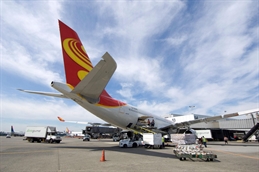
This past spring brought a pleasant surprise for Tom Green, senior manager, air cargo at Seattle-Tacoma International Airport. The problems at US West Coast ports were diverting cargo to airfreight, but Sea-Tac was not expected to become one of the conduits for this.
“We did not at first think that we would be getting too much of a bump, given the different nature of the freight and the fact that most of the volume that comes off at the port is intended for markets other than Seattle, much going inland by train. It seemed to make more sense to fly to Chicago than to Seattle, but then we did see some import growth related to the port issue,” he noted, adding that some exports that took off from Sea-Tac should have gone by ocean vessel.
Through the first four months of this year the airport’s cargo throughput was up 5.9%.
Los Angeles and San Francisco, the two major West Coast gateways further south, also clocked up spikes in tonnage. Los Angeles International Airport (LAX) handled 697,862 tonnes in the first four months of this year,13.5% more than in the same period in 2014. At San Francisco, airfreight tonnage in March was up 27.6% over March 2014.
All three gateways tabled growth in their cargo traffic in 2014. Altogether 2,001,152 tonnes passed through LAX last year, 75,102 tonnes more than in 2013. San Francisco recorded an increase of 10.1% in throughput in 2014 over the previous year. At Sea-Tac volume climbed 11.8% to reach 327,240 tonnes. Outbound traffic increased 18%, while inbound tonnage grew 22.6%.
In early June, Green was looking forward to a strong cherry crop, although not quite as strong as last year’s record-setting harvest. This should add some 15,000 tonnes to the airport’s cargo volume, he noted.
In addition to filling bellyholds of passenger planes and scheduled freighters heading out to Asia, cherries usually pull in additional freighter flights from the likes of Kalitta or Nippon Cargo, which do not fly to Sea-Tac on a regular basis.
“We now have probably 35 to 40 freighters a week. Usually we have 18 to 20 a week,” Green said.
About 60% of the airport’s volume moves on passenger aircraft. New passenger services are coming on stream, with Hainan Airlines due to launch flights to Shanghai and Emirates doubling its B777 flights to Dubai. Still, freighters remain a vital component in the mix at Sea-Tac, and Green does not expect this to change.
Cargo charter activity is up. This year, Antonov 124s have touched down already three times more than their typical appearances in a whole year. Mostly they have carried aircraft engines headed for Boeing’s assembly plant up the road in Everett.
Last year Sea-Tac completed the creation of four new hard stands for large freighters, so now it has five altogether to accommodate AN-124s and B747-8Fs.
Finding room for new cargo facilities would be less easy. Land is scarce at Sea-Tac, and the strong growth in passenger traffic (it was up over 13% in the first quarter) means that there is a strong need to expand passenger facilities.
Over time, Green expects the footprint of cargo to shrink, so he is looking to boost capacity through better efficiency when existing cargo buildings (notably those built in the 1970s and 1980s) are being replaced.
At San Francisco, another airport with space constraints, cargo capacity received a shot in the arm last year when the first phase of the West Field cargo redevelopment facility came on stream, replacing a 40-year-old cargo building. The US$35 million project created a cargo area of 5,700 square metres and some 1,300 square metres of office space, plus an adjoining hard stand.
In a recent report on airport infrastructure investment, Los Angeles ranked third among US airports in terms of good opportunities for investors looking to cargo facility development. Prior to the downturn of 2009, there were efforts to nudge freighter operators to move over to Ontario airport, located close to the Inland Empire area, which houses numerous warehouses and distribution facilities. However, in recent years LAX has continued to draw in cargo traffic, while smaller rivals have suffered.
LAX recently attracted a new international freighter link. In April, AirBridgeCargo Airlines started twice-weekly B747F service to Moscow, linking to the Russian carrier’s network beyond.
“Launching Los Angeles flights is part of our ongoing commitment to develop our presence in the US market and follows strong consumer interest in both China and the United States,” said Robert van de Weg, ABC’s senior vice president, sales and marketing.
By Ian Putzger
Air Freight Correspondent | Toronto



